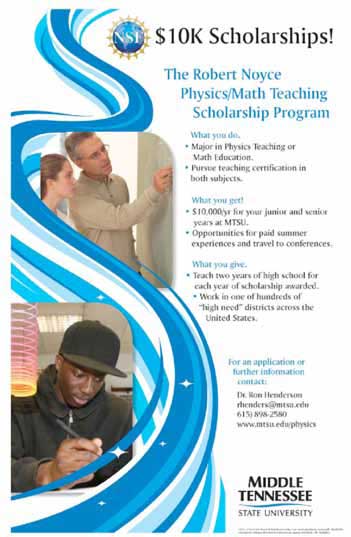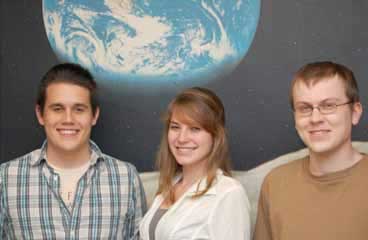Physics Teaching Embraced at MTSU with the help of PhysTEC
Ron Henderson
Middle Tennessee State University
Physics teacher education is taking center stage at Middle Tennessee State University (MTSU), and being selected as one of three new comprehensive PhysTEC sites brings added momentum to the cause. MTSU is home to 24,000 students in the geographic center of Tennessee. The physics department graduates 5.4 majors each year, with many of these students continuing to graduate school in physics, astronomy, engineering, and medical physics. It would be safe to say that very few of our majors have become secondary teachers. In fact, over the past fifteen years the number of students that completed a major in physics and became endorsed to teach high school physics has totaled, well, zero. This is not a number of which we are proud; this number has become one of the primary motivators for our new emphasis in physics teaching.
Our Path

Where to Start?
Our department is pouring energy and resources into three primary areas this year to grow our teacher education efforts: programming, marketing, and assessment. The building blocks for our program are in place, but many of the specifics are being developed this year. New courses that were approved last year need to be fully designed, and further work on existing courses needs to happen as well. We are partnering with a marketing consultant to teach us how to reach more students from our local public schools as well as targeting existing science majors at our university. In addition, we are taking a serious look at how to measure the level of success from our efforts – both by counting graduates, interacting with them to glean information about their preparedness in content and pedagogical knowledge, and documenting attitudes toward science and teaching.
Hitting the Ground Running (Thanks, PhysTEC)
Program implementation is moving ahead quickly, thanks in large part to our partnership with PhysTEC. PhysTEC has provided mentoring and advice through both one-on-one discussions and workshops that involved other PhysTEC institutions. PhysTEC funding is making many of our curriculum improvements possible. Our program implementation involves developing new courses and re-designing existing courses, combining efforts of the education and science colleges through the MTeach initiative, and adding PER expertise to our department. The curriculum reform efforts began with the development of three new courses in the physics and astronomy department this year. In Physics Licensure, students will work in a combination seminar and independent study fashion to prepare for the Praxis II content exam. This course gives our future teachers the opportunity to compile a wide range of content knowledge from many physics courses and gain confidence in their ability to pass the licensing exam. Another first-time offering this fall is Concepts and Applications of Thermodynamics and Statistical Mechanics. Our approach in this course is to emphasize a conceptual understanding of thermodynamics by focusing on seminal ideas, with exercises designed to force the students to think about how they would teach the material. Our third new course for the year is The Teaching of Physics. This course has the two goals of introducing students to PER literature through a study of “what works” in physics education, and giving students the opportunity to put those ideas into practice. The seminar portion of the course will give our future teachers an overview of research-proven pedagogies in place in university classrooms, as well as successful programs used in high schools, including the Modeling pedagogy from Arizona State University. The second component of the course will require students to work as teaching assistants in introductory physics courses that employ inquiry-based techniques. Further curriculum improvements will happen during the summer of 2011 when our calculus-based physics sequence will be re-designed to employ an active learning environment with content and techniques borrowed from other successful programs. With these changes to our curriculum, we hope to create an improved environment for future physics teachers.
Add a Dose of UTeach ...or MTeach
Our involvement with MTeach is most evident in what has historically been the education component of a science teacher’s program of study. The lines between what is education and what is science are now blurred, and the MTeach curriculum reflects this fact. Many of the MTeach courses will be taught by high school science and mathematics teachers that have joined the university faculty (Teachers in Residence (TIR) if you speak PhysTEC, or Master Teachers if you are more familiar with UTeach). Our department is particularly excited about the early teaching experience courses known as Step I and Step II. These one credit hour courses offer potential high school teachers a low-stress opportunity to experience the public school classroom as a teacher. Students will be involved first in observation and later as active participants in the classrooms of top elementary and middle school mentor teachers that will model best practices for the science classroom. We hope this experience will widen the pool of prospective high school teachers, especially among freshmen and sophomores. Students in a number of majors are required to take a year of physics, and quite a few become very interested in the department after that experience. However, because students tend to put off taking physics until their junior or senior years, they are often too close to graduation to consider a change in major after finding how great physics can be. The TIRs will also be involved in recruitment through visits to science classes on the university campus, and interacting with students in the physics department. We plan to leverage our physics TIR by inviting them to be full participants in all aspects of the department. The final piece in our implementation plan is the addition of a PER faculty line in the department. We are thrilled to have gained permission to fill a permanent tenure-track faculty line with an expert in PER. (Anyone interested in the position can apply online at mtsujobs.mtsu.edu, and contact the search committee chairman Dr. Vic Montemayor.
Who Knew?
The second major area of emphasis for the year will be in marketing. Students that become involved in our department through classes or research projects tend to have positive experiences and be drawn to the physics major/minor. Evidence of this effect comes through an analysis of the first major declared by eventual physics B.S. recipients. Not many started as physics majors, and our graduates have often changed majors to physics after a positive experience with physics and astronomy faculty. We want to learn how to engage and interest students that have not experienced our department. This may include reaching out to high school juniors and seniors, and finding a way to connect to current university students that do not yet have concrete career plans. MTSU will be partnering with marketing consultant John Rice this year to help find a way to “get the word out” to each of these populations. John has experience designing marketing plans for other physics departments, and we want to tailor a message for our student base and our region of the country. Of course, having a great tag line is not a silver bullet for an advertising a program. We know that a successful program will involve a lot of work on our part, and we are ready for the challenge and excited at the prospect. Soon there will be on-line ads, banners, t-shirts, flyers, and other advertisements to inform others about initiatives in our department. We are currently trying to secure funding for a new science building to hold all the new majors.
The Proof is in the Pudding
Assessment may not seem to have the same importance as program implementation or marketing, but we are convinced that careful attention to what our majors say and do can provide an avenue for constant improvement. Our assessment plan begins with the straightforward task of administering nationally accepted conceptual content exams at the beginning, and again at the end, of the first semester of physics. Since the declared major of students in the introductory sequence is not a good indicator of their eventual degree, the test is given to all students in both the algebra- and calculus-based sequences. After the introductory sequence, much of the follow-up data is collected from declared majors during their senior year: by again administering conceptual content exams, by requiring participation in a scientific attitudes survey, and by evaluating students’ opinions regarding the quality of the department and their perceived level preparation for their career of choice. Another means of assessment centers on the required capstone thesis course and subsequent presentation. All physics majors must complete a year-long research project in their area of interest that culminates with a presentation to the faculty and students of the department. Many majors work with research faculty in our department, while others participate in REU programs throughout the country and abroad. Students in niche areas, such as physics teaching and medical physics, are allowed to conduct projects linked to their area of expertise. A physics teaching candidate might study an aspect of our inquiry-based pedagogy that would include quantitative assessment, or could produce inquiry-based lesson plans for topics that have not received widespread coverage in the literature. During the thesis presentation students are evaluated by department and visiting faculty. To further quantify performance on the capstone project, a rubric is being designed to facilitate measurement the quality of each written thesis. We hope that enough information can be collected from these sources to allow a critical look at our program and suggest avenues for improvement.
Let’s Start Cooking

The first physics teachers that will graduate from Middle Tennessee State University as part of the PhysTEC program: (left to right) Paul Turner, Hilary Ball, and Dylan Russell.
Ron Henderson is chairman of the Department of Physics and Astronomy at Middle Tennessee State University where he is co-PI of a NSF Robert Noyce Scholarship grant and PI of the MTSU PhysTEC grant.
Disclaimer - The articles and opinion pieces found in this issue of the APS Forum on Education Newsletter are not peer refereed and represent solely the views of the authors and not necessarily the views of the APS.
